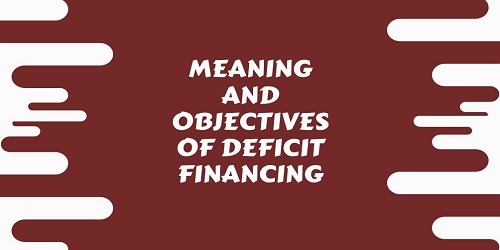Table of Contents
Meaning and Objectives of Deficit Financing:
Meaning of Deficit Financing:
The term deficit financing has different connotations, arising out of differences in the concept of a budget deficit, until recent years, a budget was considered a surplus or deficit, according to the position of the revenue accounts of the government. Thus a surplus budget was one in which revenue receipts exceeded expenditure charged to the revenue account regardless of the gap in capital accounts; while a deficit budget was one in which expenditure was greater than current revenue receipts. Public borrowings were not included in the receipts side, but the proceeds of public loans utilized for bridging the gap between revenue and expenditure were considered deficit spending or deficit financing. In modern times, however, borrowings from the general public are included in the receipts of the government in the capital account, and if, even then there remains a gap between receipts and expenditure, the methods of Financing are referred to as deficit financing. Thus, the loans raised from the public or commercial banks are treated as the receipts of the government in the capital account and they are not accounted for as deficit financing. In other words, the volume of deficit financing is measured in terms of the overall budget deficit which means the aggregate of the deficit on both the revenue and capital accounts.
Techniques of Deficit Financing:
There are three important techniques through which the government may finance its budgetary deficits. They are as follows:
(1) Borrowing from the Central Bank, i.e., creation of new money.
(2) The running down of accumulated cash balances. It implies the withdrawal of cash balances by the government from the Central Bank to finance the budgetary deficit, i.e., increasing the supply of money.
(3) The government may issue new currency.
It is, thus, obvious, that all these methods lead to an increase in the supply of money. To put it in the words of R. N. Tripathi, “Thus deficit financing by Government for filling up the gap in its investment budget would result mainly in an outright expansion of currency.”
Objectives of Deficit Financing:
(1) Deficit financing has generally been used as a method of meeting the financial needs of the government in times of war when it has been considered difficult or mobilizing adequate resources for financing war expenditure through normal methods of raising resources.
(2) It has been also advocated by Prof. J. M. Keynes as an instrument of economic policy for removing the conditions of depression and raising the level of output and employment.
(3) The use of deficit financing has also been considered essential for financing the plans of economic development, especially in underdeveloped countries.
(4) Deficit financing is also advocated for the mobilization of surplus, idle, and unutilized resources in the economy.









Comments (No)